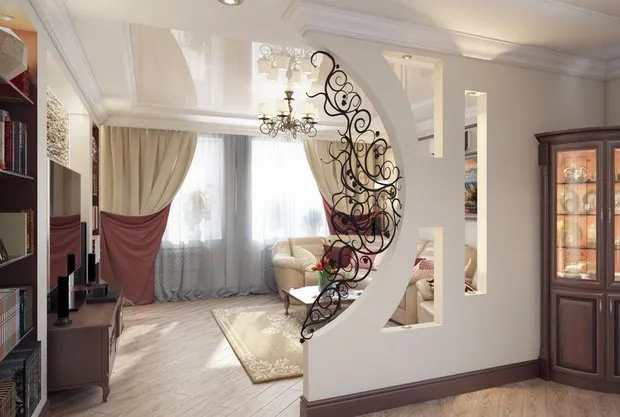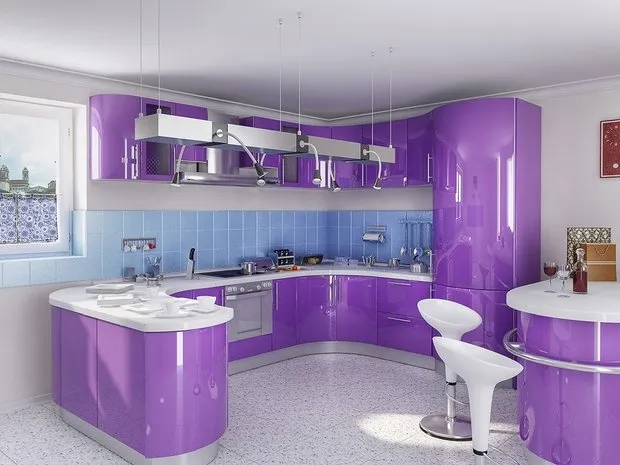There can be your advertisement
300x150
5 Interior Design Trends from the 1990s That Should Be Left Behind
High ceilings, ornate kitchens, and other features of outdated interior design
An expert named the most outdated interior design trends that are better left in the past.
Anna Budnikova — architect-designer and co-founder of M-A SPACE studio
Elements of luxury
 Photo: pinterest.ru
Photo: pinterest.ruThe 1990s have passed, yet the desire to decorate homes more luxuriously and fill them with as many items as possible remains. Decorative elements, moldings, gilded details, velvet, heavy chandeliers and furniture are now considered relics of the past. Moreover, prolonged exposure to rooms filled with gold can negatively affect a person's psychological and emotional state.
Today, minimalism, Mediterranean style, or cottagecore are preferred. This is justified: simplicity, functionality, and light, airy spaces do not cause repulsion.
Nevertheless, elements of luxury may still be appropriate in large apartments or mansions, but placing them tastefully without the help of a designer is quite difficult.
Excess of details
 Photo: pinterest.ru
Photo: pinterest.ruWhen decorating a home, it's important to maintain moderation in small details like paintings, figurines, vases, etc. An overabundance of elements creates both visual and physical discomfort—the items gather dust and clutter the space. People tire more quickly in overly packed rooms, whereas minimalistic and bright spaces tend to reduce feelings of depression.
If there are meaningful items, one should approach their placement thoughtfully. Unique pieces can serve as focal points in the interior, while items of the same color palette or style should be grouped on shelves. However, some of these items are better hidden away.
Overuse of partitions and zoning elements
 Photo: pinterest.ru
Photo: pinterest.ruCreating small rooms or zones should be well-justified. For example, installing solid partitions may be necessary if a family has many members and each requires their own personal space. It's best not to overdo storage spaces or lofts in hallways, as they significantly reduce space and create a suffocating effect. These can be replaced with built-in wall cabinets, sofa beds, platforms, and more.
Today’s clients often prefer studio apartments or large living rooms combined with kitchens. For zoning, we use transformable or glass partitions to visually expand the space.
Heavy gypsum ceilings and niches
 Photo: pinterest.ru
Photo: pinterest.ruThe trend of multi-level ceilings, along with other excesses, belongs to the past.
Flat ceilings, such as suspended ones, are now more relevant. They can accommodate any light fixture or chandelier and blend well into any interior, unlike questionable multi-tiered structures. It's better to focus attention on other design elements instead.
Gypsum niches in walls are also impractical: over time, their corners begin to wear and deteriorate, especially in angular constructions.
Ornate kitchens
 Photo: pinterest.ru
Photo: pinterest.ruPlanning and layout of the kitchen are among the most meticulous aspects of interior design. Even today, many apartments still feature bulky blocks with "curls" and gilded handles from the 1990s or worse—acidic bright tones of kitchens from the early 2000s.
We recommend choosing a kitchen in the same style as the overall interior. Today, there are many unique solutions that allow making the kitchen area a focal point for people—where one can not only cook but also relax or work on a laptop. In such cases, excesses distract and eventually cause fatigue. This is especially important when designing a kitchen-living room combination. It's best to make appliances built-in and surfaces neutral.
Main photo: pinterest.ru
More articles:
 5 favorite design tricks designers can easily replicate
5 favorite design tricks designers can easily replicate How to Properly Choose Curtain Material, Color, and Size for Interior
How to Properly Choose Curtain Material, Color, and Size for Interior IKEA vs Designer: How They Decorated a 58 m² Two-Room Apartment in a Panel Building
IKEA vs Designer: How They Decorated a 58 m² Two-Room Apartment in a Panel Building Top 10 Men's Gifts from AliExpress You'll Definitely Want to Buy!
Top 10 Men's Gifts from AliExpress You'll Definitely Want to Buy! Where to Place a Washing Machine: 9 Ideas from Designers
Where to Place a Washing Machine: 9 Ideas from Designers 5 Things in Your Home Where You Absolutely Cannot Cut Costs
5 Things in Your Home Where You Absolutely Cannot Cut Costs Cool IKEA Gifts from 299 Rubles: 10 Ideas for Him and Her
Cool IKEA Gifts from 299 Rubles: 10 Ideas for Him and Her What to Make Floors From in a Small Studio? 7 Successful Examples
What to Make Floors From in a Small Studio? 7 Successful Examples